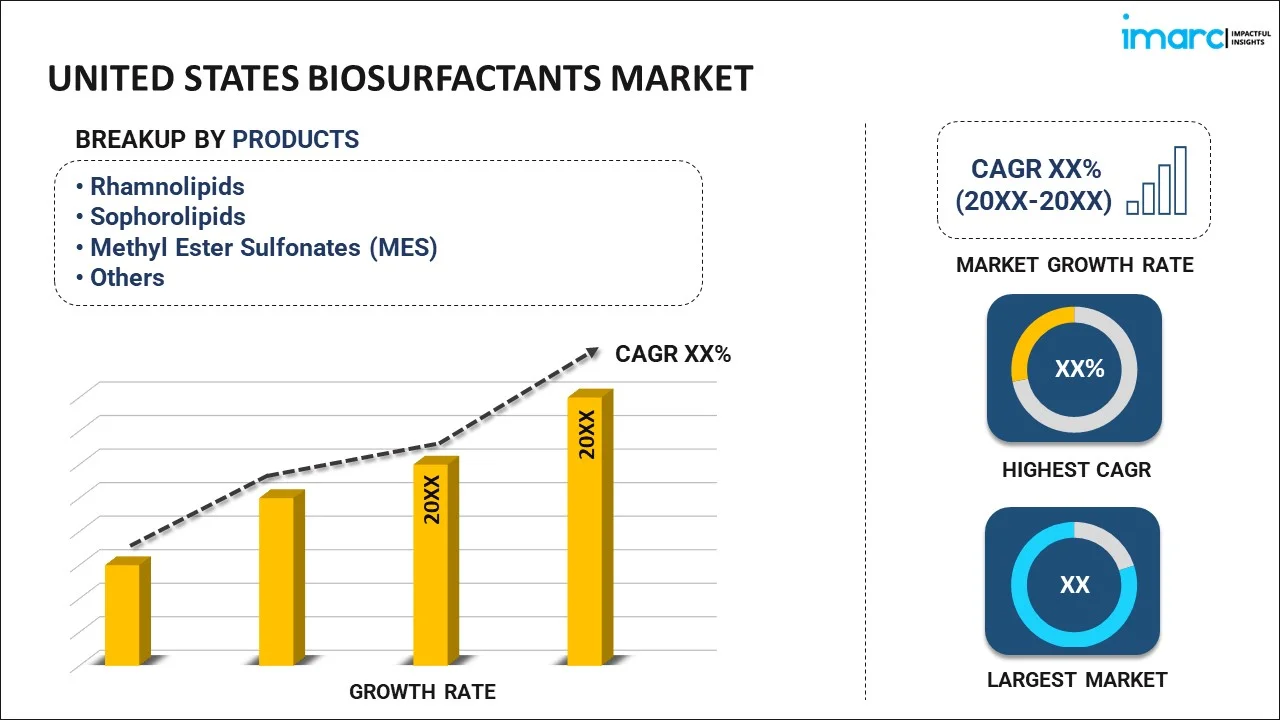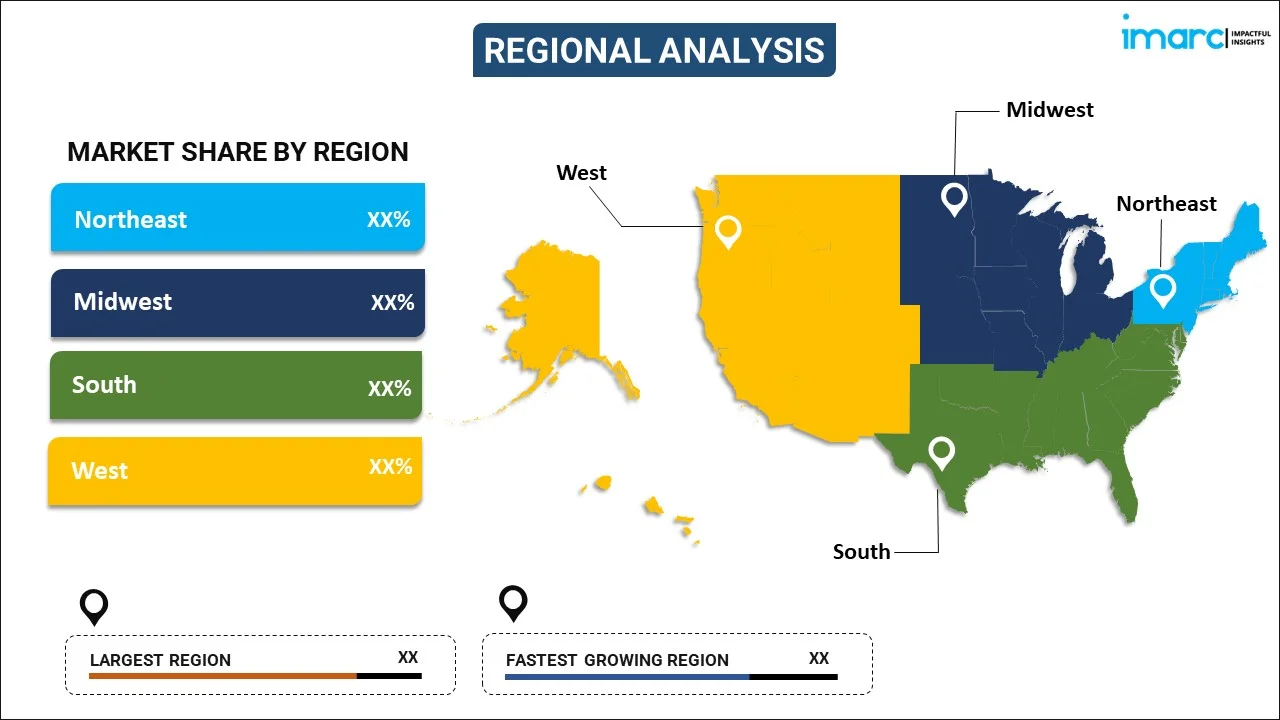
United States Biosurfactants Market Report by Product (Rhamnolipids, Sophorolipids, Methyl Ester Sulfonates (MES), Alkyl Polyglucosides (APG), Sorbitan Esters, Sucrose Esters, and Others), Source (Bacteria, Fungi, Agricultural Waste, Agro-Industrial Waste), Application (Household Detergents, Personal Care, Industrial Cleaners, Food Processing, Oilfield Chemicals, Agricultural Chemicals, Textiles, and Others), and Region 2025-2033
Market Overview:
United States biosurfactants market size is projected to exhibit a growth rate (CAGR) of 5.70% during 2025-2033. The increasing advancements in the production processes of biosurfactants, such as genetic engineering techniques and optimization of fermentation methods, which can lead to cost-effective and scalable production, are driving the market.
|
Report Attribute
|
Key Statistics
|
|---|---|
|
Base Year
|
2024 |
|
Forecast Years
|
2025-2033
|
|
Historical Years
|
2019-2024
|
| Market Growth Rate (2025-2033) | 5.70% |
Biosurfactants are natural compounds produced by microorganisms, plants, or animals with unique surface-active properties. Unlike synthetic surfactants, biosurfactants are environmentally friendly and biodegradable. They play a crucial role in various industrial, agricultural, and medical applications. These molecules reduce surface tension and enhance the solubility of hydrophobic substances, making them valuable in industries such as petroleum, food, and pharmaceuticals. Biosurfactants exhibit diverse structures, including glycolipids, lipopeptides, and phospholipids. Due to their biocompatibility and low toxicity, they find applications in bioremediation, where they aid in the cleanup of oil spills and other environmental pollutants. Additionally, biosurfactants possess antimicrobial properties, making them potential candidates for medical and therapeutic purposes. The exploration of biosurfactants continues to expand, highlighting their sustainable and versatile nature in addressing various challenges across different industries.
United States Biosurfactants Market Trends:
The biosurfactants market in the United States is experiencing robust growth driven by several key factors. Firstly, the increasing awareness and emphasis on sustainable practices in industries have propelled the demand for eco-friendly alternatives, and biosurfactants stand out as a viable solution. Moreover, the escalating concerns about environmental degradation and the need to reduce the ecological footprint have prompted industries to adopt biosurfactants over traditional chemical surfactants. Furthermore, advancements in biotechnology and microbial fermentation processes have significantly improved the production efficiency of biosurfactants, making them more commercially viable. As a result, the cost-effectiveness of biosurfactant production has increased, further fueling market expansion. Additionally, stringent regulations governing the use of conventional surfactants, due to their adverse environmental impact, have led to a surge in the adoption of biosurfactants as a compliant and sustainable alternative. Moreover, the versatile applications of biosurfactants across various industries, including agriculture, food, pharmaceuticals, and oil and gas, contribute to their growing market prominence. The inherent biodegradability and low toxicity of biosurfactants align with the regional shift towards green chemistry, positioning them as a preferred choice among consumers. In conclusion, the biosurfactants market in the United States is thriving, propelled by a confluence of factors rooted in environmental consciousness, technological advancements, and regulatory imperatives.
United States Biosurfactants Market Segmentation:
IMARC Group provides an analysis of the key trends in each segment of the market, along with forecasts at the country level for 2025-2033. Our report has categorized the market based on product, source, and application.
Product Insights:

- Rhamnolipids
- Sophorolipids
- Methyl Ester Sulfonates (MES)
- Alkyl Polyglucosides (APG)
- Sorbitan Esters
- Sucrose Esters
- Others
The report has provided a detailed breakup and analysis of the market based on the product. This includes rhamnolipids, sophorolipids, methyl ester sulfonates (MES), alkyl polyglucosides (APG), sorbitan esters, sucrose esters, and others.
Source Insights:
- Bacteria
- Fungi
- Agricultural Waste
- Agro-Industrial Waste
A detailed breakup and analysis of the market based on the source have also been provided in the report. This includes bacteria, fungi, agricultural waste, and agro-industrial waste.
Application Insights:
- Household Detergents
- Personal Care
- Industrial Cleaners
- Food Processing
- Oilfield Chemicals
- Agricultural Chemicals
- Textiles
- Others
The report has provided a detailed breakup and analysis of the market based on the application. This includes household detergents, personal care, industrial cleaners, food processing, oilfield chemicals, agricultural chemicals, textiles, and others.
Regional Insights:

- Northeast
- Midwest
- South
- West
The report has also provided a comprehensive analysis of all the major regional markets, which include Northeast, Midwest, South, and West.
Competitive Landscape:
The market research report has also provided a comprehensive analysis of the competitive landscape in the market. Competitive analysis such as market structure, key player positioning, top winning strategies, competitive dashboard, and company evaluation quadrant has been covered in the report. Also, detailed profiles of all major companies have been provided.
United States Biosurfactants Market Report Coverage:
| Report Features | Details |
|---|---|
| Base Year of the Analysis | 2024 |
| Historical Period | 2019-2024 |
| Forecast Period | 2025-2033 |
| Units | US$ Million |
| Scope of the Report | Exploration of Historical and Forecast Trends, Industry Catalysts and Challenges, Segment-Wise Historical and Predictive Market Assessment:
|
| Products Covered | Rhamnolipids, Sophorolipids, Methyl Ester Sulfonates (MES), Alkyl Polyglucosides (APG), Sorbitan Esters, Sucrose Esters, Others |
| Sources Covered | Bacteria, Fungi, Agricultural Waste, Agro-Industrial Waste |
| Applications Covered | Household Detergents, Personal Care, Industrial Cleaners, Food Processing, Oilfield Chemicals, Agricultural Chemicals, Textiles, Others |
| Regions Covered | Northeast, Midwest, South, West |
| Customization Scope | 10% Free Customization |
| Report Price and Purchase Option | Single User License: US$ 3699 Five User License: US$ 4699 Corporate License: US$ 5699 |
| Post-Sale Analyst Support | 10-12 Weeks |
| Delivery Format | PDF and Excel through Email (We can also provide the editable version of the report in PPT/Word format on special request) |
Key Questions Answered in This Report:
- How has the United States biosurfactants market performed so far and how will it perform in the coming years?
- What has been the impact of COVID-19 on the United States biosurfactants market?
- What is the breakup of the United States biosurfactants market on the basis of product?
- What is the breakup of the United States biosurfactants market on the basis of source?
- What is the breakup of the United States biosurfactants market on the basis of application?
- What are the various stages in the value chain of the United States biosurfactants market?
- What are the key driving factors and challenges in the United States biosurfactants?
- What is the structure of the United States biosurfactants market and who are the key players?
- What is the degree of competition in the United States biosurfactants market?
Key Benefits for Stakeholders:
- IMARC’s industry report offers a comprehensive quantitative analysis of various market segments, historical and current market trends, market forecasts, and dynamics of the United States biosurfactants market from 2019-2033.
- The research report provides the latest information on the market drivers, challenges, and opportunities in the United States biosurfactants market.
- Porter's five forces analysis assist stakeholders in assessing the impact of new entrants, competitive rivalry, supplier power, buyer power, and the threat of substitution. It helps stakeholders to analyze the level of competition within the United States biosurfactants industry and its attractiveness.
- Competitive landscape allows stakeholders to understand their competitive environment and provides an insight into the current positions of key players in the market.
Need more help?
- Speak to our experienced analysts for insights on the current market scenarios.
- Include additional segments and countries to customize the report as per your requirement.
- Gain an unparalleled competitive advantage in your domain by understanding how to utilize the report and positively impacting your operations and revenue.
- For further assistance, please connect with our analysts.
 Inquire Before Buying
Inquire Before Buying
 Speak to an Analyst
Speak to an Analyst
 Request Brochure
Request Brochure
 Request Customization
Request Customization




.webp)




.webp)












